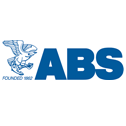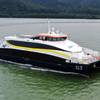ABS and DSME Offer New Sloshing Analysis Methodology for FLNG
(Houston, TX---) Class society ABS and Korea’s Daewoo Shipbuilding & Marine Engineering (DSME) are concluding a one-year joint development program (JDP) examining critical wave conditions for sloshing model tests and computational fluid dynamics (CFD) in the cargo tanks of floating liquefied natural gas (FLNG) vessels.
The results will offer the industry a new methodology to determine critical sloshing conditions more efficiently than in the past and the methodology promises to be valuable in reducing the cost and time duration for sloshing test campaigns.
Designing for sloshing impact loads is a key concern in tank containment system design. As the cargo tanks have increased in size along with various filling conditions for offshore FLNG operations, the possibility of severe sloshing becomes more likely as well as the probability of structural damage to the containment system. The new ABS-DSME methodology is being proposed as a pre-screening procedure for selecting the most severe critical sea states before the start of a sloshing model test or sloshing flow simulation.
“Model tests can not cover all possible wave height, period, heading and filling levels since there are just too many combinations to determine the life time maximum sloshing loads,” observes Yung Sup Shin, Head of the Containment System Group, ABS Corporate Technology. “However, we have developed a robust way to determine a finite number of critical sloshing conditions consistently and efficiently compared to other existing methods.”
The methodology, explains Shin, consists of two main steps. A sloshing pseudo-response amplitude operator (RAO) is defined based on the total sloshing wave energy and, secondly, the concept of sloshing severity is introduced based on the area under the sloshing energy response spectrum curve. This highly advanced theoretical formulation represents ship motion and sloshing interaction calculating the energy of the liquid cargo in the tank.
The numerical analysis of the fluid motion from this theoretical methodology has been validated by comparing the results to those from conventional sloshing tests for an FLNG cargo tank.
Shin points out that the validation is based on extensive sloshing model test data developed from a joint industry project (JIP) by DSME using Gas Transport & Technigaz (GTT NO 96) membrane containment system for an FLNG with a two-row cargo tank with centerline cofferdam arrangement. ABS was a participant in this two-row JIP along with other class societies and energy majors.
It is important to include any critical sea state in a sloshing test matrix, however, current state-of-the-art CFD codes have a limited value for evaluating the life time design sloshing pressures due mainly to the lack of computational efficiency. Shin says the total sloshing wave energy and severity computation developed jointly by ABS and DSME provides an alternative to selecting relevant sea states in sloshing model testing and analysis.
This new advanced numerical approach will join other methods of sloshing assessment developed over the past decade such as sloshing flow simulation techniques, scaling laws, fluid-structure interaction, corrugation effects on sloshing and partial filling operation.
Shin says associated software to carry out the sloshing methodology for site specific offshore FLNG application is expected to be available in May.
Founded in 1862, ABS is a leading international classification society devoted to promoting the security of life, property and the marine environment through the development and verification of standards for the design, construction and operational maintenance of marine-related facilities.
Source: Eagle.org













